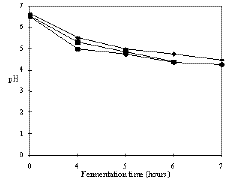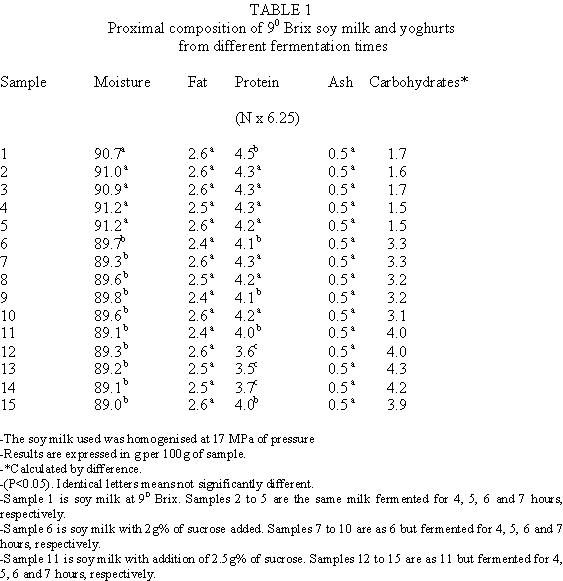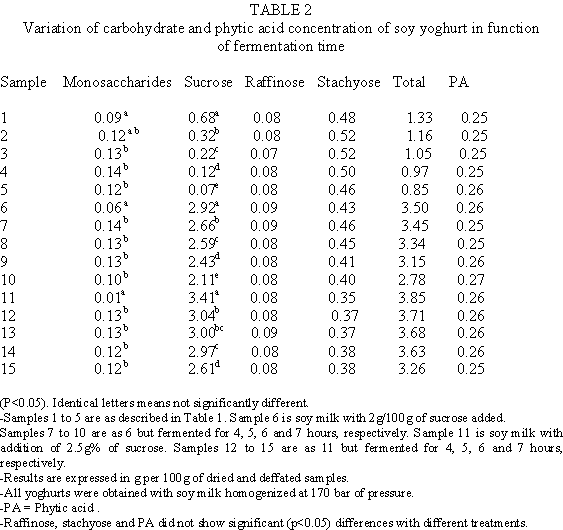Servicios Personalizados
Revista
Articulo
Indicadores
-
 Citado por SciELO
Citado por SciELO -
 Accesos
Accesos
Links relacionados
-
 Similares en
SciELO
Similares en
SciELO
Compartir
Archivos Latinoamericanos de Nutrición
versión impresa ISSN 0004-0622versión On-line ISSN 2309-5806
ALAN v.51 n.1 supl.51 Caracas mar. 2001
Development and sensory evaluation of soy milk based yoghurt
C . S. Fávaro Trindade, Terzi, S. C., L.C. Trugo, R. C. Della Modesta, S. Couri
Universidade Federal Rural do Rio de Janeiro, EMBRAPA-CTAA, Rio de Janeiro, Instituto de Química,
Universidade Federal do Rio de Janeiro, Brazil
SUMMARY.
Yoghurts were prepared by fermentation of soy milk using a mixed starter culture containing Lactobacillus bulgaricus and Streptococcus thermophilus. Soy milk at 90 Brix was homogenised under pressure (17 MPa) and fermented with and without addition of sucrose (2.0 and 2.5 g per 100 g) for 4, 5, 6 and 7 hours. The yoghurts were evaluated in terms of sensory qualitty, pH, titrable acidity, phytic acid and oligosaccharides: A yoghurt with the best sensory quality was obtained using the homogenised soy milk with 2% sucrose addition and fermented for 6 h. Lactobacillus bulgaricus and Streptococcus thermophilus did not produce phytases and a-galactosidases at the experimental conditions, consequently, phytic acid and galactosides were not affected by the process.
Key words: Soymilk, soy yoghurt, yoghurt sensory analysis, phytate, alpha-galactosides.
RESUMO.
Desenvolvimento e avaliação sensorial de iogurte de soja. Foram elaborados iogurtes através da fermentação de leite de soja, usando uma cultura mista de Lactobacillus bulgaricus e Streptococcus thermophilus. O leite de soja com 90 Brix foi homogeinizado sob pressão (17 MPa) e fermentado com e sem adição de sacarose (2,0 e 2,5 g por 100 g) por 4, 5, 6 e 7 horas. Os iogurtes obtidos foram analisados em relação as características sensoriais, pH, acidez titulável, fitatos e oligossacarídeos. Foi obtido um iogurte com ótimas qualidades sensoriais, a partir do leite de soja homogeinizado, com adição de 2% de sacarose e fermentado por 6 h. Os microrganismos utilizados não produziram fitases e a-galactosidases e, consequentemente, os teores de a-galactosídeos e de fitatos não foram alterados pelo processamento.
Palavras-chave: Leite de soja, iogurte de soja, análise sensorial, fitato, alfa-galactosídeos.
Recibido: 22-10-1999
Aceptado: 18-09-2000
INTRODUCTION
Many soy products have limited human use in the Western hemisphere due to undesirable off-flavours (1,2). Fermentation processes, which have long been used in the Orient, may improve the sensorial attributes and also to decrease or mask the properties of undesirable compounds contributing to the production of better derived soy products (1). Lactic acid fermentation has been reported as a mean to reduce beany flavours and anti-nutritional factors, such as phytic acid, in soy bean products and together with the addition of sweeteners it is possible to obtain products with better acceptance by panellists (2,3).
The presence of galactosides such as raffinose and stachyose in soybean products leads to controversial opinions among researchers because these oligosacharides are not digested by non-ruminants consequently forming gases in the large intestine (4). In contrast, galactosides are considered as probiotics and are in fact added to specific products with therapeutic purposes (5).
Soy-based foods may provide additional benefits for the consumer for example due to their hypolipidemic, anti-cholesterolemic and counteratherogenic properties and also to their reduced allergenicity (6). Consequently, soy milk based yoghurts offer a considerable appeal for a growing segment of consumers with certain dietary and health concern. In addition, soy milk yoghurt have several nutritional advantages over cow milk yoghurt such as, reduced levels of cholesterol, of saturated fat and free of lactose. Although some reports are found in the literature dealing with soy milk yoghurt production, not so many data are available providing a complete characterization of the products, including the sensory evaluation and the residual amounts of phytates and a-galactosides
Thus, the purpose of the present study was to develop soy milk yoghurts with good acceptability, to characterize the products in terms of their composition and evaluate the fate of the phytates and alpha-galactosides after processing.
MATERIALS AND METHODS
Yoghurt production
Soy milks were prepared with soybean [Glycine Max (L.) Merril], cultivar EMBRAPA-4, supplied by SPSB-EMBRAPA, Ponta Grossa-PR, Brazil. The milk was obtained by using a procedure already described in the literature (7). The soy milk homogenization process and the yoghurt production were based on previous descriptions(8). The soy milk temperature was adjusted to 45oC, inoculated with 3% commercial yoghurt culture (50:50 mixture of Lactobacillus delbruckii subsp. bulgaricus and Streptococcus salivarus subsp. thermophilus from Chr. Hansen's (Brazil) and incubated from 4 to 7 h at 45oC. The experiments were conducted using soy milk at 90 Brix homogenised at 17 MPa and with addition of sucrose in the concentrations of 2.0 or 2.5 g per 100g of soy milk. Fermentation times were of 4, 5, 6 and 7 h periods.
Analytical procedures
Moisture, protein and ash values were determined using standard A.O.A.C. procedures (9) and fat was determined by the Bligh-Dyer method (10).
Samples were freeze-dried, milled and then passed through a 0.75 mm sieve. The initial moisture content of the samples were taken into account for data comparison. All results were reported on a wet weight basis. For sugar determination the samples were previously deffated with petroleum ether. All determinations were made in triplicate.
Titratable acidity was estimated by titrating 10 g of sample with 0.1N NaOH using phenolphthalein as the indicator. Changes in pH were followed using a pHmeter (Micronal, Brazil).
The determination of soluble solids in the soy milk (from 0o to 32°Brix) was carried out using a refractometer, (Atago, USA).
Phytic acid determination was achieved by ion exchange chromatography followed by a colorimetric reaction (11).
Oligosaccharides were extracted from the samples and purified prior to high-performance liquid chromatography (12). A HPLC equipment with a 20ml loop and a refractive index detector (Waters, USA) was used with a Silica-NH2 column of 250 x 4.6 mm, id. (Waters, USA) at a flow rate of 1.0 ml/min. Standard solutions of glucose, fructose, sucrose, lactose, raffinose, mellibiose and stachyose were used for peak identification. Quantification was achieved by external standardisation using an electronic integrator (Waters, USA).
Sensory analysis
Eleven trained judges were selected based on their ability to discriminate and reproduce the results.
All samples were served at temperatures of 7-10oC using plastic cups labelled with three-digit codes from a random number table. Water was available for panel members to rinse their mouths between samples. Crakers were supplied as needed to aid in removing beany flavour between tasting.
The round table discussion and the paired directional two-sided comparison test were applied (13). The tests were conducted in partitioned booths with fluorescent lighting. The sensory analysis was directed to identify the best product by the formulation of the following questions to the panel: 1)which sample has the better consistency?; 2) which sample has the better taste?.
Analysis of variance was used for statistical treatment of the data (p<0.05)
RESULTS AND DISCUSSION
Effect of fermentation
The coagulation of soy milk yoghurt occurred within 4 hours of fermentation, with pH of 5,5 and titratable acidity of 0,24% (as lactic acid %) These results were similar to those obtained when lactic-acid bacteria activity in soymilk was studied (14).
As shown in the Figures 1 and 2 the titrable acidity increased and pH decreased as a function of fermentation time, particularly in the samples enriched with sucrose hich is in agreement with other observations (2,15). Acid production in the medium depends upon the growth of the organisms and their ability to ferment the available carbohydrates. S. thermophilus readly utilises sucrose, the major fermentable sugar in soybeans, and produces substantial amounts of acid in soy milk, however, L. bulgaricus is unable to use this sugar (16). After 7 h of fermentation the pH obtained was 4.5 which is quite acceptable for yoghurts (17).
Variation of titratable acidity in function
of fermentation time

¨
Standard fermentation?
Fermentation with 2% sucrose additionh
Fermentation with 2.5% sucrose addition
Variation of pH in function of fermentation time

¨
Standard fermentation?
Fermentation with 2% sucrose additionh
Fermentation with 2.5% sucrose addition
The proximal composition of soy milk before and after fermentation at different times is presented in Table 1. The results did not show any great differences when compared with other soy milks described in the literature (3). The carbohydrate composition showed that the a-galactosides are readly extracted from the flour, with stachyose largely predominant over raffinose (Table 2). The presence of chromatographic peaks that appear within the first 5 min of analysis, with similar retention times for glucose, fructose and galactose, in addition to the galactosides which are eluted later in the chromatogram have been reported (16). In the present work a small peak appeared with a similar retention time of glucose and this was considered to represent the total monosaccharides present in the samples.
The amount of monosaccharides increased significantly (P<0.05) with the fermentation in all treatments probably due to the hydrolysis of major carbohydrates with higher degree of polimerization.
L. bulgaricus and S. thermophilus do not possess a-galactosidade activity but S. thermophilus has invertase activity (16). In the present work while raffinose and stachyose concentrations were not significantly reduced (P<0.05), a reduction in sucrose of 90% was reached, as shown in Table 2, supporting the indication of low a-galactosidase and high invertase activities.
According to the results shown in Table 2, the phytic acid concentration did not change significantly (P<0.05) during fermentation in any one of the studied conditions indicating that the bacteria used is not efficient to decrease this anti-nutritional factor extracted from the soy flour.

Sensory characteristics of yoghurt
Although some authors have used cow milk based yoghurt for panellists to be compared with soy milk based yoghurt (2,19), in the present work the panel concluded that the two yoghurts are two different products, therefore, the cow milk yoghurt can not be reference. The most relevant attributes of soy milk yoghurt determined by the taste panel were: a) visual texture (great syneresis); b) texture or consistency in the mouth (consistent, firm, creamy, chalky, airy, and greasy); c) taste (soy, bitter, oil, sweet, acid, bean, and nut).
In preliminary experiments the panel rejected the yoghurt prepared with 50 Brix soy milk because of consistency. Excessive syneresis after 20 h of production could be an effect of the use of 13 MPa of pressure for homogenization. However, they did not detect any significant difference (p<0.05) between pressures of 17 and 20 MPa, when evaluated by the paired directional two-sided comparison test. The panel also rejected glucose in favour of sucrose which they considered to be a better sweetner then glucose. Based on these information, further experiments were carried out using only sucrose as sweetner, soy milk at 90 Brix and 17 MPa of homogenization pressure and the other results were discharged.

The selection of treatments with sucrose rather then glucose addition by the panel is somehow in accordance with results described elsewhere (3) since sucrose appears to have the property of masking the usual beany flavour detected in soy derived products.
Samples submitted to 4 h of fermentation were considered to have little yoghurt characteristics in contrast with 7 h, which were considered to have better quality. The panel also described a decrease in chalkiness and an increase in astringency in the 7h of fermentation samples. Samples with 2.5% of added sucrose and submitted to 5 h fermentation and with 2% sucrose and 6 h fermentation were selected as having better global quality.
In conclusion, soy milk yoghurt prepared from a 90 Brix soy milk, with the addition of 2% sucrose before fermentation, homogenised under pressure of 17 MPa and fermented for 6h was considered the better product and presented a great potential for commercial production.
ACKNOWLEDGMENTS
The authors would like to thank CNPq, FAPERJ and EMBRAPA-Agoindústria de Alimentos for the financial support.
REFERENCES
1. Kanda H, Wang HL, Hesseltine CW, Warner K. Yoghurt production by Lactobacillus fermentation of soybean milk. Proc. Biochem. 1976; 1: 23-25. [ Links ]
2. Pinthong R, Macrae R, Rothwell J. The development of a soya-based yoghurt. Part II: sensory evaluation and analysis of volatiles. J. Food Techn. 1980; 15: 647-652. [ Links ]
3. Buono MA, Setser C, Erickson LE, Fung DYC. Soymilk yoghurt: sensory evaluation and chemical measurement. J. Food Sci. 1990; 55: 528-531. [ Links ]
4. Olson AC, Gray GM, Gumbmann MR, Sell CR and Wagner JR. Flatulence causing factors in legumes. In Antinutrientes and Natural Toxicants in Foods, ed.R.L. Ory, pp. 275-294. Food and Nutrition Press Inc., Westport, CT, 1981. [ Links ]
5. Kailasaphathy K, Rybka SL. Acidophilus and B. Bifidobacterium spp. _their therapeutic potential and survival in yogurt. The Australian J Dairy Techn., 1997; 52: 28-35. [ Links ]
6. Sipos EF. Edible uses of soybean protein. Presented at Soybean Utilisation Alternatives Symposium. Univ. of Minnesota, Feb. 16-18, Minneapolis, MN. 1988. [ Links ]
7. Wilkens WF, Mattick LR, Hand DB. Effects of processing method on oxidative off-flavors of soybean milk. Food Techn., 1967; 21: 86-89. [ Links ]
8. Fávaro Trindade CS, Cascardo Silva F, Freitas S, Couri S. Comportamiento reologico de los "yogurts" de soya homogeneizados y no homogeneizados. Alimentaria, 1997; 285: 67-73. [ Links ]
9. A.O.A.C. Official methods of analysis. ed., Association of Official Analytical Chemists, Washington, DC, USA, 1984. [ Links ]
10. Bligh EG, Dyer WJ. A rapid method of total lipid extraction and purification. Can J Bio Chem Physiol. 1959; 37: 911-917. [ Links ]
11. Harland BF & Oberleas D. A modified method for phytate analysis using an ion exchange procedure. Application to texture vegetable proeins. Cereal Chem., 1977; 54: 827-832. [ Links ]
12. Shukla VKS. Quantitative determination of oligossaccharides in defatted soybean products by high speed liquid chromatography. Fett Wissenschaft Tecnologie, 1987; 89: 5-79. [ Links ]
13. Meilgaard M, Civille GV, Carr BT. Sensory evaluation techniques. Boca Raton: CRC Press, v. 1, 125 p; v. 2, 159 p, 1987. [ Links ]
14. Angeles AG, Marth EH. Growth and activity of lactic-acid bacteria in soymilk. I: growth and acid production. J Milk and Food Techn., 1971; 34: 30-36. [ Links ]
15. Wang S, Marinho CS, Carvalho EP. Produção de Yoghurt de soja com diferentes associações de bactérias láticas. Pesq Agropec Bras., 1994; 29: 1593-1601. [ Links ]
16. Mital BK, Steinkraus KH. Growth of lactic acid bacteria in soy milks. J Food Sci, 1974; 39: 1018-1022. [ Links ]
17. Tamine AY, Robinson RK. Yogur ciencia y tecnologia. Zaragoza: Acribia, 502 p., 1991. [ Links ]
18. Mital BK, Steinkraus KH. Flavor acceptability of unfermented and lactic-fermented soy milks. J. Milk Food Techn., 1976; 39: 342-344. [ Links ]














